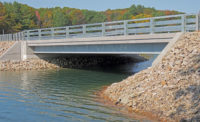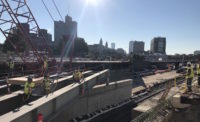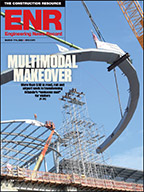Bridge Replacement Work to Bring $7-Million of Incentive Pay
"It was a two-hour move to get the precast in. We poured concrete from midnight to 3 a.m.," Cahill says. The team had to prepare the ground, setting precise locations for the cranes and every bit of precast as if they were conducting "an orchestrated piece of music," he adds. "To set 36 pieces of precast in 12 hours, we couldn't afford [delays]."
Critical Planning
J.F. White-Kiewet and Tetra-Tech, the Pasadena, Calif.-based lead design engineer for highway and traffic management, dedicated six months to planning and met with various stakeholders on top of the previous six months of outreach by MassDOT, Harney says. Recently, contractors working on the congested 405 freeway in Los Angeles avoided congestion problems by completing their work early.
"The biggest challenge was getting info out to the driving public," says MassDOT Highway Administrator Frank DePaola. The agency managed traffic using an online virtual messaging system that gave estimated driving times for detours on digital roadside display boards. To avoid bottlenecks, the agency kept on-site emergency vehicles and tow trucks on call throughout construction so that any breakdowns or fender benders could be cleared quickly without causing gridlock.
The American Association for State Highway and Transportation Officials cited "93 Fast 14" for an innovation award for developing an efficient system to repair MassDOT's backlog of structurally deficient bridges in an area traveled by 200,000 vehicles daily. It also received a $1-million grant from the Federal Highway Administration and national attention for innovation it used to replace the 60-year-old bridges quickly and safely with minimal impact to commuters.
Note to Editors:<br/>Great stroy. However it fails to make any mention of the company that performed the actual work of pre-casting all the bridges. This work was performed by Jersey Pr...
Great stroy. However it fails to make any mention of the company that performed the actual work of pre-casting all the bridges. This work was performed by Jersey Precast of Hamilton, NJ
and also fail to mention the name of the person who coordinated all the precast drawings.
I would like to add one point that was a key element to making this project such a success. The skill and hard work of the men and women of Boston's Building Trades Unions. They work...
You have to love the union chest thumping BOSSES who were the saving graces of the project.
What I don't understand is the experimentation necessary for the testing of rapid setting concrete. Why could there not have been a research program conducted over the years for such a ...
but since it was not even given a minor "aging" test, it seems to me to be too much of an unnecessary gamble for such an important project.





